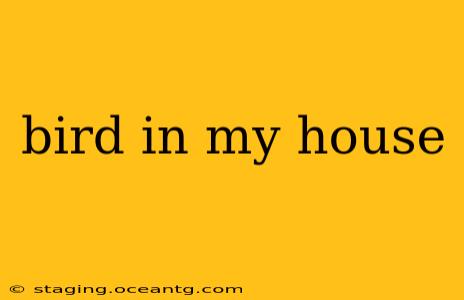Finding a bird in your house can be quite a surprise! Whether it's a tiny hummingbird or a larger bird like a sparrow, the situation requires a calm and careful approach. This guide will walk you through identifying the bird, safely removing it, and preventing future visits.
How to Identify the Bird in Your House
Before you attempt to remove the bird, try to identify the species. This can help determine the best course of action. Observe its size, color, markings, and behavior. You can use online resources like the Audubon Society's website or a bird identification app to help with identification. Knowing the type of bird can inform you about its potential needs and how best to assist it.
What to Do if a Bird is Injured
If the bird appears injured—if it's bleeding, has broken wings, or seems lethargic—do not attempt to handle it directly. Injured birds can bite or scratch in self-defense. Instead, contact your local wildlife rehabilitation center or animal control. They have the expertise and resources to provide appropriate care.
How to Get a Bird Out of Your House Safely
The most humane and effective way to remove a healthy bird from your house is to gently encourage it to leave on its own.
- Open all windows and doors: This creates escape routes for the bird. Turn off any lights to discourage it from flying around erratically.
- Close off other rooms: Confining the bird to one room simplifies the process of guiding it outside.
- Create a safe exit: Consider placing a blanket or towel over a window to create a darker, less stressful escape route.
- Use a broom or long object: Gently guide the bird towards an open window or door. Never corner or trap the bird. Avoid sudden movements that may frighten it.
- Be patient: This may take some time. The bird might be disoriented or stressed, so allow it to calm down before trying to guide it out.
Why is a Bird in My House?
This question often arises. Birds often enter houses accidentally, usually through open windows, doors, or gaps in the walls or roof. Sometimes, they are drawn in by bright lights or the reflection of glass. They might also be seeking shelter from bad weather or predators.
What should I do if a bird keeps coming back?
Persistent bird visits indicate a potential attractant. Check for food sources, water sources, or nesting materials near your home. Clean up any spilled seeds, birdseed, or crumbs. Secure any gaps or openings that provide easy entry points.
How can I prevent birds from entering my house?
Prevention is key. Consider installing bird netting over open windows or vents, particularly during migration seasons. You can also install screens or mesh on your windows, and regularly inspect your house for any gaps or cracks. Keep windows closed when not in use, especially during dawn and dusk when birds are most active.
What if a bird is nesting in my house?
Nesting birds are protected under the Migratory Bird Treaty Act. Disturbing a nest is illegal and harmful to the birds. Instead, contact wildlife authorities or a bird expert who can advise you on the best course of action.
What if I find a dead bird in my house?
Finding a deceased bird can be unsettling. Wear gloves to safely remove the bird and dispose of it appropriately. Depending on local regulations, you may need to place it in a sealed bag and dispose of it in the trash or contact your local waste management service.
By following these guidelines, you can effectively and humanely address the situation of a bird in your house, ensuring the safety and well-being of both the bird and yourself. Remember, patience and a calm approach are key.
